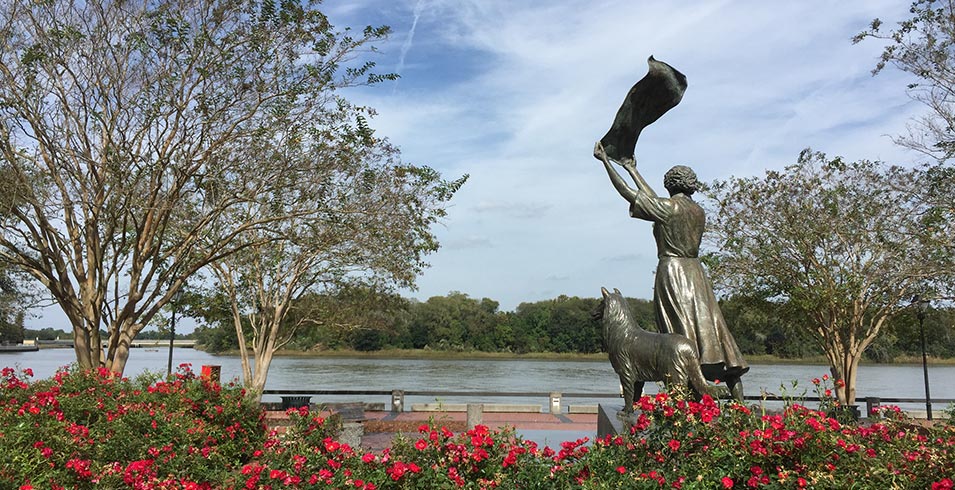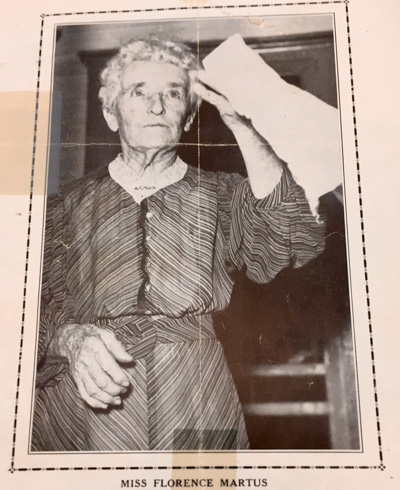get to know the story behind the Waving Girl statue in Savannah

The young lady who greeted the passing ships in Savannah, Georgia, was a genuine symbol of southern hospitality. Day and night, she waved, welcoming, and bidding farewell to the hardworking sailors she encountered. Her cheerful efforts established her as an exciting part of maritime history, as well as one of the highlights of Savannah’s coast.
Florence Martus, also known as Savannah’s Waving Girl, was born on August 7th, 1869, in Cockspur Island, Georgia. Her father, John H. Martus, was a German-born Ordnance Sergeant at the island’s Fort Pulaski, appointed to supervise fort repairs following its bombardment by the Union.

After Florence was born, the Martus family moved to the nearby Elba Island, where her father assumed the role of the lighthouse keeper. While living on the island, a powerful hurricane destroyed their home, forcing the family to flee and settle in Savannah. Several years later, upon John Martus’ passing, his son George took over as the lighthouse keeper, and both him and Florence moved back to Elba Island.
Following their move, Florence began to stand on the edge of the Savannah River and wave at every passing ship, a habit she maintained for 44 years. She would wave a handkerchief or a towel during the daytime and a lantern during the night time. When ship captains spotted her, they would often acknowledge her by sounding their horn three times. According to legend, not one ship was missed during the four decades she was on duty. In 1931, George retired, and they both left the island.
Florence Martus passed away in Savannah on February 8th, 1943, three years after her beloved brother. The siblings were buried side-by-side in the northern portion of Laurel Grove Cemetery. Their headstone reads: "In memory of the waving girl and her brother. Keepers of the lighthouse on Elba Island, Savannah River for 35 years."
Over the years, many have come up with fanciful explanations for why Florence waved at the passing ships. Locals claim that in 1887, Florence fell in love with a naval officer who sailed away but promised to return. To help him spot her, she started standing by the river and gesturing at the moving vessels. Although they were never reunited, she remained hopeful for the rest of her life, making sure he saw her if he ever came back.
Although most would likely prefer the sad love story, Florence herself claimed that she did it simply because she was lonely. She was a young girl living on an isolated island, with nothing to do but stare at the water, and wait for ships to pass.
During the early 1960s, a preservation movement swept Savannah, motivating locals to restore the historic churches and houses that remained, as well as the city’s significant waterfront. As part of this initiative, the city decided it would be appropriate to erect a monument honoring Savannah’s Waving Girl, and funds immediately started to be collected.
The process took several years, but finally, in 1968, the money was available to finance the project. The initial plan was to place the statue in Washington Square, which is part of Savannah’s Historic District. However, the community determined that the ground in the square could not support the weight of the monument. They also agreed the statue would be out of place in the city center. The city concluded that the perfect location would be Morrell Park on East River Street, overlooking the waterfront.
Austrian-born artist Felix de Weldon designed the monument. De Weldon, who was a distinguished sculptor at the time, is best known for creating the Marine Corps War Memorial in Virginia (also known as the Iwo Jima Memorial), and the Simón Bolívar Statue in Washington, D.C. The sculptor’s initial draft was modified based on the feedback he received from the locals who wanted the monument to capture Florence’s essence perfectly.
The 9-foot tall bronze statue stands on a large platform and depicts young Florence wearing a simple short-sleeved dress, with both hands holding a flowing handkerchief. At her feet, we find the lantern she used to salute ships at night. By her side, we see a large Rough Collie, representing the dogs she and George bred on the island. Although De Weldon initially drew Florence barefoot, the artist modified the sketch to add a pair of shoes after a local store described the footwear Florence had purchased from them.
The Waving Girl Statue was cast in Rome, Italy, and dedicated in 1972, a year after it arrived in Savannah. According to the locals, the captain who brought the statue refused payment because of the fond memories he had of Florence. To this day, some ships blow their horn to salute the monument when entering the Savannah River.
After the Waving Girl’s passing, the Propeller Club of Savannah named a Liberty ship after her. The SS Florence Martus was revealed in 1943 with a massive celebration on Cockspur Island. According to the Georgia Historical Society, the SS Florence Martus was the 30th out of 88 Liberty ships built in Savannah. Throughout the years, these historic vessels have been scrapped, and only a handful remain today.
The Savannah Belles Ferry system that provides transport to several destinations across the Savannah River has four vessels in their fleet named after notable women of the city. One is named after Juliette Gordon Low, founder of the Girls Scouts of the USA; the second is named after Susie King Taylor, a free African-American who educated black soldiers during the Civil War; the third is named after Mary Musgrove, a Native American who assisted General Oglethorpe during the founding of the Georgia colony; and the fourth is named after Florence Martus, Savannah’s celebrated Waving Girl.
Savannah’s Waving Girl Statue can be found on the east-end of River Street, near the river itself. Specifically, it is in Morrell Park.
Morrell Park
423 River Street
Savannah, GA 31401
Gallivanter offers the widest variety of highly-rated tours in Savannah. Make sure to book one for your trip to Savannah!
Our Savannah Tours